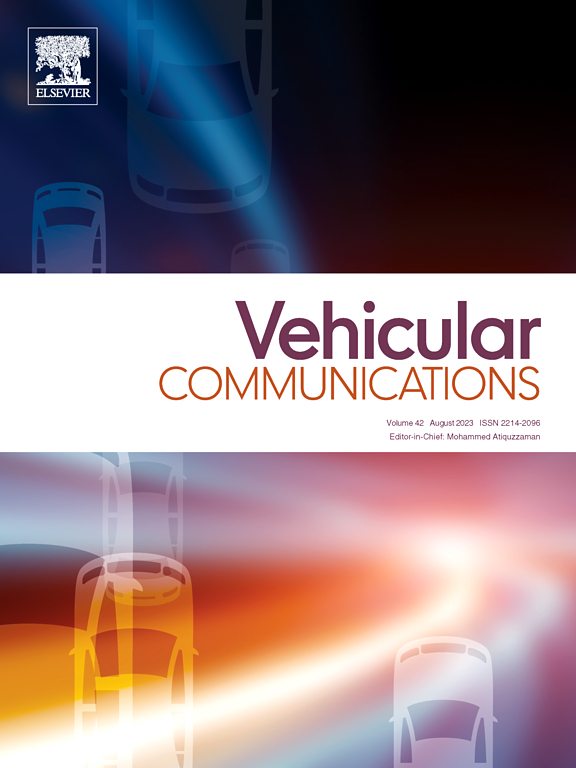Joint carrier frequency offset, doubly selective channel estimation and data detection for RIS assisted MIMO OFDMA uplink system
IF 6.5
2区 计算机科学
Q1 TELECOMMUNICATIONS
引用次数: 0
Abstract
With the presence of an array of passive elements embedded in a reconfigurable intelligent surface (RIS), estimation of time-varying channels between a fast-moving user and the fixed base station (BS) is more challenging than conventional static channels. In this paper, we propose a joint technique for the estimation of carrier frequency offset (CFO) and doubly selective channel (DSC), and data detection in the RIS-assisted multiple input multiple output (MIMO) orthogonal frequency division multiple access (OFDMA) uplink system. The time variations of the channel within the OFDMA symbol are represented using the basis expansion model (BEM), significantly reducing the number of estimated parameters. An autoregressive (AR) model is used to characterize the variations in BEM coefficients and CFOs over successive OFDMA symbols. A novel technique of combining the Schmidt extended Kalman filtering (SEKF) and Gaussian particle filtering (GPF) integrated with an iterative detector and decoder (IDD) receiver structure (IDD-SKGPF) is proposed to estimate the BEM coefficients, CFOs and to detect the symbols in two stages. Performance of the proposed method is evaluated using normalized mean square error (NMSE) and compared with the derived Bayesian Cramer-Rao bound (BCRB) and modified BCRB. Furthermore, the reflection coefficient is optimized in the time domain by maximizing the achievable rate to demonstrate that the exploitation of RIS may result in significant bit error rate (BER) performance improvement of in SNR over non optimized RIS scenario even under high mobility scenarios.
RIS辅助MIMO OFDMA上行系统的联合载波频偏、双选择信道估计和数据检测
由于在可重构智能表面(RIS)中嵌入了一组无源元件,快速移动用户与固定基站(BS)之间时变信道的估计比传统的静态信道更具挑战性。在本文中,我们提出了一种用于ris辅助多输入多输出(MIMO)正交频分多址(OFDMA)上行系统中载波频偏(CFO)和双选择信道(DSC)估计以及数据检测的联合技术。使用基展开模型(BEM)表示OFDMA符号内信道的时间变化,大大减少了估计参数的数量。使用自回归(AR)模型来表征连续OFDMA符号上BEM系数和cfo的变化。提出了一种结合施密特扩展卡尔曼滤波(SEKF)和高斯粒子滤波(GPF)和迭代检波解码器(IDD)接收机结构(IDD- skgpf)的新技术,用于估计边界元系数、CFOs和分两阶段检测符号。采用归一化均方误差(NMSE)评价了该方法的性能,并与推导的贝叶斯Cramer-Rao界(BCRB)和改进的BCRB进行了比较。此外,通过最大化可实现的速率,在时域上优化反射系数,以证明即使在高移动场景下,RIS的利用也可能导致在信噪比下比未优化的RIS方案显著提高6dB的误码率(BER)性能。
本文章由计算机程序翻译,如有差异,请以英文原文为准。
求助全文
约1分钟内获得全文
求助全文
来源期刊

Vehicular Communications
Engineering-Electrical and Electronic Engineering
CiteScore
12.70
自引率
10.40%
发文量
88
审稿时长
62 days
期刊介绍:
Vehicular communications is a growing area of communications between vehicles and including roadside communication infrastructure. Advances in wireless communications are making possible sharing of information through real time communications between vehicles and infrastructure. This has led to applications to increase safety of vehicles and communication between passengers and the Internet. Standardization efforts on vehicular communication are also underway to make vehicular transportation safer, greener and easier.
The aim of the journal is to publish high quality peer–reviewed papers in the area of vehicular communications. The scope encompasses all types of communications involving vehicles, including vehicle–to–vehicle and vehicle–to–infrastructure. The scope includes (but not limited to) the following topics related to vehicular communications:
Vehicle to vehicle and vehicle to infrastructure communications
Channel modelling, modulating and coding
Congestion Control and scalability issues
Protocol design, testing and verification
Routing in vehicular networks
Security issues and countermeasures
Deployment and field testing
Reducing energy consumption and enhancing safety of vehicles
Wireless in–car networks
Data collection and dissemination methods
Mobility and handover issues
Safety and driver assistance applications
UAV
Underwater communications
Autonomous cooperative driving
Social networks
Internet of vehicles
Standardization of protocols.
 求助内容:
求助内容: 应助结果提醒方式:
应助结果提醒方式:


